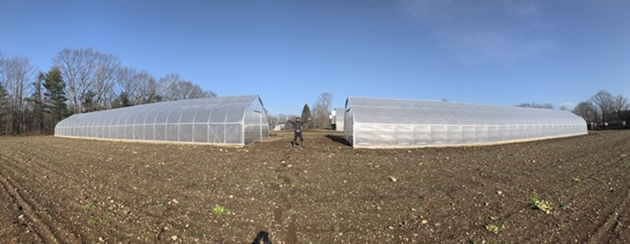- 10 Ways to Extend Your Season with Protected Cultivation
- QuickHoops Gothic High Tunnel Bender | Construction Manual for Modular Moveable Gothic High Tunnel (PDF)
- QuickHoops Gothic High Tunnel Bender | Construction Manual for Stationary Gothic High Tunnel (PDF)
- QuickHoops High Tunnel Bender | Construction Manual for Building a Stationary High Tunnel (PDF)
- QuickHoops Low Tunnel Benders | Instruction Manual (#9377 & #9520) | (PDF)
- Agribon+ AG-19, 30, 50 & 70 Row Cover | Insert (PDF)
- Hitch Mount for QuickHoops Low Tunnel Benders | Instruction Manual (PDF)
- Bobcat Automatic Ventilation Kit Manual (#6791) | Tech Sheet (PDF)
- Bobcat Pro High Tunnel Kit Manual (#6794) | Tech Sheet (PDF)
- Bobcat Pro High Tunnel Kit (#6794) | Parts List (PDF)
- Bobcat Sliding Door Kit Manual (#6792) | Tech Sheet (PDF)
- Bobcat Standard High Tunnel Kit Manual (#6795) | Tech Sheet (PDF)
- Bobcat Standard High Tunnel Kit (#6795) | Parts List (PDF)
- Bobcat Steel End Wall Kit Manual (#6793) | Tech Sheet (PDF)
- Truss Support Kit Manual (#6790) | Tech Sheet (PDF)
- Bobcat Tunnel Kits | Comparison Chart
- Beginning & Intermediate Controlled Environment Agriculture (CEA) | Advances in Greenhouse Crop Production
- 5 Cool Flowers to Plant Now | Lisa Mason Ziegler's Secrets for Growing Hardy, Cool-Season Annuals
- Hoop Loops | Installation Instructions | Tech Sheet (PDF)
- Introduction to Overwintering Flowers | Guide to Overwintering Flowers
- Overwintering Perennial Herbs
- Protect Your Crops | High & Low Tunnel Basics
- The Effect of Shorter Daylength on Winter Production
- Be First & Last to Market by Extending Your Growing Season
- Quick Hoops Low Tunnels | Set-up & Management with Eliot Coleman
- Constructing the Modular Moveable Gothic Tunnel – Animated Schematic
- Moving the Modular Moveable Gothic Tunnel – Slideshow
- Skinning the Modular Moveable Gothic High Tunnel – Slideshow
- Overwinter Flower Trials | Multiyear Results for 30+ Crops | Johnny's Selected Seeds | XLSX
- Seeding Date Calculator | Johnny's Recommended Flowers for Overwintering | XLSX
- Overwintering Onions from Seed | Johnny's Selected Seeds
- Winter Growing Guide | Part 5: Overwintering Planting Dates
- Pest & Disease Control Basics in Greenhouse, Hydroponic & Other Protected-Culture Systems
- Pests & Diseases of Greenhouses & Hydroponic Systems | Tech Sheet (PDF)
- Why & What to Grow in a Greenhouse? Basics of Protected Culture
- Recommended Varieties from Our Greenhouse Trials | What We Look for in Greenhouse Crops
- QuickHoops 3'W x 4.5'H Low Tunnel Bender (#7616) | Instruction Manual (PDF)
- Cable Purlin Trellis for QuickHoops High Tunnels | Installation Manual (PDF)
- QuickHoops Moveable High Tunnel Bender | Instruction Manual (PDF)
- QuickHoops Seedling & Microgreens Bench | Construction Guide (PDF)
- Row Cover & Insect Netting Options & Uses | Comparison Chart (PDF)
- Tufflite IV Greenhouse Film | Comparison Chart (PDF)
- Univent Automatic Opener for BiFold Doors | Instruction Manual (PDF)
- Video: Johnny's Season Extension & Overwintering Trials
- Video: Planning & Planting the Autumn Vegetable Garden | Tips & Recommendations with Niki Jabbour
- Video: Growing Under Cover with Niki Jabbour | Johnny's Webinar Series
- Video: Veggie Remix: Bring New Flavors & Colors Into Your Garden | Johnny's Webinar Series
- Video: Cover Cropping for Field & Garden with Collin Thompson | Johnny's Webinar Series
- Video: DIY Cold Frame • Easy How-to Tutorial with Niki Jabbour
- Video: Tips & Crop Recommendations for the Autumn and Winter Cold Frame • Tutorial with Niki Jabbour
- Video: How to Use Quick Hoops™ Benders to Create High & Low Tunnels
- Video: The Benefits of Row Covers | Recommendations & Tips
- Video: Hoop Houses & Other Ways to Extend Your Growing Season
- Video: Take a Tour with Us of Johnny's Greenhouses!
- Growing Under Cover with Niki Jabbour & Johnny's | Johnny's Educational Webinar Resources
- Johnny's Winter Growing Guide | Printable Brochure (PDF)
- Winter Growing Guide | Part 2: Production in the High Tunnel
- Winter Growing Guide | Part 1 - Introduction
- Winter Growing Guide | Part 3: Overwintering in Low Tunnels
- Winter Growing Guide | Part 6: Recommended Crops & Varieties
- Winter Growing Guide | Part 4: Planting Dates for a Winter Harvest
- When to Start Seeds for Overwintered Flowers | Guide to Overwintering Flowers
- Choosing Flower Crops to Overwinter | Guide to Overwintering Flowers
- Video: Winter Sowing & Milk-Jug Greenhouses | With Niki Jabbour & Johnny's
- Video: Irrigation Considerations for the Overwinter Flowers Tunnel | Johnny's Selected Seeds
- Webinar Slide Deck | Overwintering Flowers | 41-pp PDF
- Gardening in a Cold Frame With Niki Jabbour
by Lynn Byczynski, Author & Founder of Growing for Market
The two primary environmental factors that affect plant growth are temperature and day length. Temperature is easy enough to understand: Every plant species has a temperature range in which it will grow, and optimum temperatures in which it will thrive. Day length is a little more complicated, especially in combination with temperature. Understanding the relationship between the two can lead to more successful season extension and variety selection.
The first thing to know is that although it is the term of art, use of the term day length in reference to most flowering plant's lifecycles is somewhat of a misapprehension — in this respect: Scientific research has confirmed that it's the length of the dark periods, not the length of daylight periods, that predominantly controls plant growth. This fact was discovered long after day length became a widely used term in horticulture, and the term has stuck. Understanding the importance of dark periods can come in handy for the grower, though, because it can be used to modify plants' response to day length, leading them to bloom outside their normal season. More on that later.
Many plant species have day length triggers that determine when they grow vegetatively and when they bloom. They may be long-day plants or short-day plants. Some plants do not react to day length; they are called day-neutral.
Figuring Day Length at Your Latitude
Day length is a function of latitude; all locations having the same latitude coordinate have the same amount of daylight on any given day. Day is equal to night, 12 hours each, at the two equinoxes, which mark the beginning of spring and the beginning of fall. The winter solstice marks the shortest day (longest night), and the summer solstice marks the longest day (shortest night) of the year. In the winter, days are longer the closer you are to the equator, and in the summer, days are longer the farther you are from the equator.
Compare day length in Maine and Florida on the summer and winter solstices:
| Location | Day Length at Summer Solstice | Day Length at Winter Solstice |
| Portland, Maine | 15 hr, 26 min | 8 hr, 55 min |
| Miami, Florida | 13 hr, 45 min | 10 hr, 32 min |
How Day Length Affects Crop Production
Most plants do not grow when day length is less than 10 hours. Even if the temperature is kept within the optimum range — for example, in a climate-controlled greenhouse — most plants will just sit dormant until the magic 10 hours of light per day arrives.
Compare dates when day length is less than 10 hours in several US cities:
| Location | Dates When Day Length is Under 10 Hr |
| Atlanta, Georgia | December 8 — January 4 |
| Washington, DC | November 19 — January 26 |
| New York, New York | November 14 — January 30 |
| Portland, Maine | November 8 — February 4 |
Because most plants won't grow when they receive less than 10 hours of daylight, winter greenhouse production requires supplemental lighting, as well as, oftentimes, supplemental heat. Lights can be turned on shortly before sunset to extend the length of the day. Or, they can be turned on in the middle of the night for a short period of time, a procedure called night-interruption lighting.
This brings us back to the fact that it's the dark period that generally has a stronger regulatory effect on a plant's life cycle than the light period: The short days of winter have long nights. If a grower breaks up those long nights by turning on lights in the middle of the night, some plants will act as though the night is short (and, therefore, the day is long), and behave just as they would in the middle of summer. Many bedding plant and cut-flower greenhouse producers use night-interruption lighting to force flowers to bloom in winter.
3 Examples
Even for growers who don't use supplemental lighting, the facts about day length are pertinent. Here are some examples of why day length may be a factor in gardening success:
- Cauliflower starts to develop a head when days get shorter. That happens sooner in northern than in southern regions, which means cauliflower will produce a crop earlier in Maine than in Virginia. Cooler temperatures during head development also lead to better flavor. So cauliflower is an easier crop in the north than in the south.
- Basil does not grow during the short days of winter, even in a tropical greenhouse. Supplemental lighting and heat are required to get good winter yields, and in most places the energy costs must be weighed carefully against the income from a basil crop.
- Flower growers are especially subject to the rules of day length because many of the most popular cut flowers have day length triggers. Rudbeckia, for example, grows vegetatively during short days and flowers when days are long. If you plant rudbeckia in early spring, you can grow big, healthy plants that send up bountiful long stems as the days get longer in summer. If you plant them in late summer, however, hoping for a fall crop, you will get few flowers on very short stems because the day length is too short to trigger blooming.
Many other aspects of food and flower crop production are affected by day length, temperature, or a combination of the two. If you have ever wondered why certain crops do not grow as well for you as they do in other parts of the country, day length may be a contributing factor.
If you are not attuned to the day length in your location, get a sunrise/sunset calculator or app, and mark your calendar with the dates when you have 10 hours of daylight, 11 hours, 12 hours, and so on. Over time, you will begin to notice correlations between day length and your garden's activity.
The Effect of Shorter Daylength on Winter Crop Production
Byczynski and her family have been growing vegetables and cut flowers since 1988, selling through CSAs, at farmers' markets, to chefs, grocery stores, and florists. They currently grow cut flowers and hoophouse tomatoes on about 2 acres of their 20-acre farm near Lawrence, Kansas.
She is also the author/editor of two of our favorite books about market farming, The Flower Farmer and The Hoophouse Handbook.



